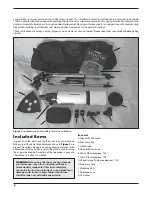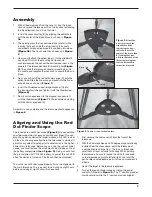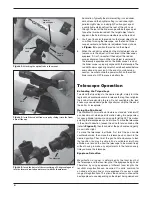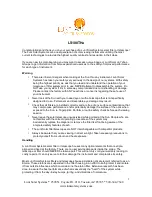
Moon is during the full Moon phase. That’s because sunlight
shines directly downward on the lunar surface, so no shadows
are cast by the moon's topography.
Telescope Care and
Maintenance
If you give your telescope reasonable care, it will last a lifetime.
Store it in a clean, dry, dust-free place, safe from rapid changes
in temperature and humidity. Do not store the telescope out-
Figure 11.
When not in use, store the two eyepieces in their bolt
cases, the diagonal, and the red dot finder scope in the zippered
accessory pouch.
Figure 10.
All included components of the StarBlast 102mm fit
neatly in the included carrying case.
doors, although storage in a garage or shed is okay. Keep the
dust cover on the front of the telescope when it is not in use.
Your refractor telescope requires very little mechanical main-
tenance. The optical tube has a smooth painted finish that is
fairly scratch-resistant. If a scratch does appear on the tube, it
will not harm the telescope. If you wish, you may apply some
auto touch-up paint to the scratch. Smudges on the tube can be
wiped off with a soft cloth and household cleaning fluid.
Everything Fits in the Carrying Case!
The StarBlast 102mm refractor comes complete with a soft
case (J) that neatly holds all its components
(Figure 10)
. The
telescope optical tube and tripod both fit inside the case, sepa-
rated by a protective divider to keep them from contacting each
other. The tripod accessory tray fits in a pocket inside the case.
The case is equipped with both hand straps and a shoulder
strap for convenient transport of your telescope wherever you
go! The eyepieces and red dot finder scope should be kept in
the included small accessory pouch (H) inside the larger case
(Figure 11)
. Each eyepiece comes with a white plastic “bolt
case” designed to protect and keep the eyepiece clean when
it’s not in use.
Cleaning Optics
Any quality optical lens cleaning tissue and optical lens cleaning
fluid specifically designed for multi-coated optics can be used
to clean the lenses of your telescope and eyepieces. Never use
regular glass cleaner or cleaning fluid designed for eyeglasses.
Before cleaning, remove any loose particles or dust from the
lens with a blower bulb or soft brush. Then apply some cleaning
fluid to a tissue, never directly on the optics. Wipe the lens gently
in a circular motion, then remove any excess fluid with a fresh
lens tissue. Oily fingerprints and smudges may be removed
using this method. Use caution; rubbing too hard may scratch
the lens. On larger lenses, clean only a small area at a time,
using a fresh lens tissue on each area. Never reuse tissues.
When bringing the telescope inside after an evening’s viewing
it is normal for moisture to accumulate on the lenses due to the
change in temperature. We suggest leaving the telescope and
eyepieces uncovered overnight to allow the condensation to
evaporate.
7





















